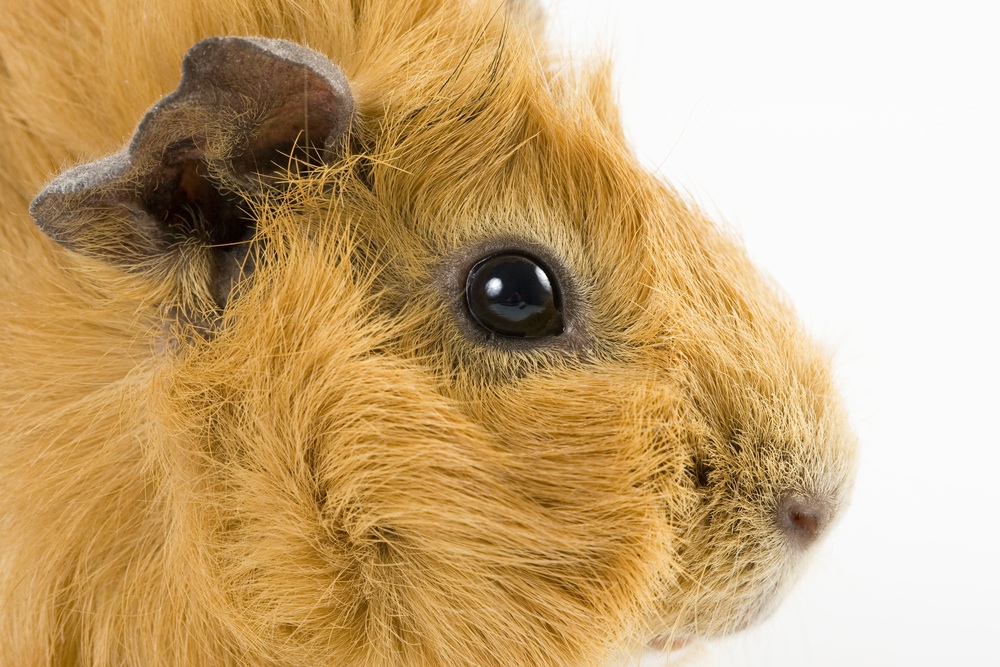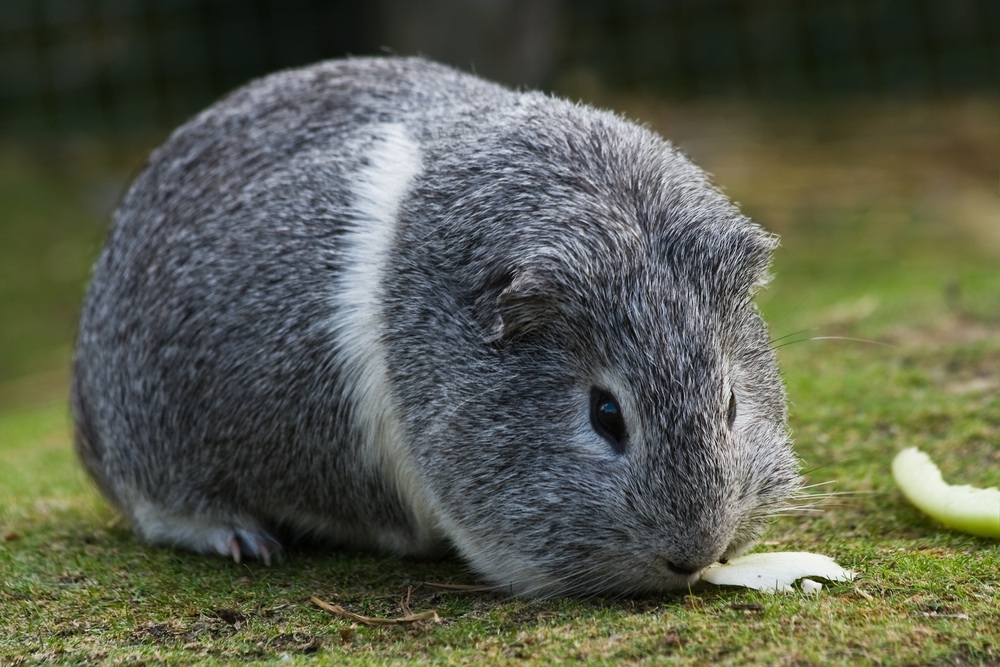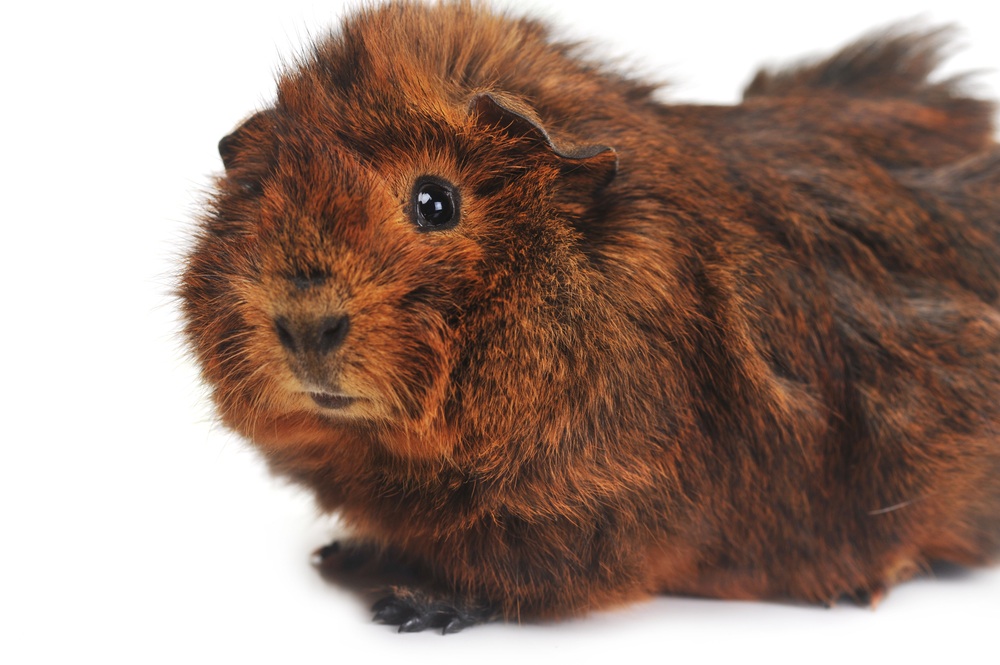Guinea pigs

The guinea pig or cavy (Cavia porcellus) is a South American rodent, whose wild relatives live in the vicinity of the Andean mountains. They were originally domesticated there centuries ago, and allowed to run around homes where they were kept as a source of food. Guinea pigs were first brought to Europe during the late 1500s, and were soon in great demand among the wealthy as pets during that period.
They are ideal companions for children, becoming very friendly if handled regularly from an early age, and unlike most rodents, their calls are easily audible. In fact, their “oinking” calls help in part to explain their name, being not dissimilar to those of a pig. Perhaps not surprisingly as a result, male guinea pigs are called boars whereas females are known as sows.
Housing
It is quite possible to keep guinea pigs either outside, in a suitable hutch, or alternatively in the home. They should not be transferred, however, from the relative warmth of a pet store environment to an outdoor hutch in the winter when the weather is likely to be cold. There are a number of different designs of hutches suitable for guinea pigs on the market. Those intended for outdoor use should be divided into two sections, one of which is sealed off against the elements.
Guinea pigs originate from an area of the world where it typically becomes very cold at night, but they dislike damp conditions. Their hutch must therefore be kept dry, with roofing felt not just on the roof, but possibly extending to the sides and back of the hutch as well. The floor area should be as large as possible, although the height of the hutch is less significant, because guinea pigs do not climb, neither do they sit up on their haunches, running around instead on all four legs.
Site the hutch out of the direction of the prevailing wind, in a sheltered area of your garden. You can then have a separate run, which will allow your pet out to exercise and feed on the lawn on fine days, or possibly even a run which attaches to the hutch itself. This can be a more cumbersome arrangement however, particularly as the run will need to be moved around the lawn at intervals, to prevent the grass dying off. Part of the run should be covered to provide protection in case it rains while your pet is out here.
The run also needs to be secure, to prevent would-be predators such as foxes and cats from being able to harm the guinea pigs. A box filled with hay will allow them to feel more secure, as they can burrow into this out of sight, if they feel threatened while out in the run
A hutch can be used to house guinea pigs in the home as well, but more commonly now, special runs are being used for this purpose. These are easy to clean, consisting of a plastic base with a detachable wire top which will be needed to exclude other household pets such as dogs or cats. Once again, as with a hutch, line the floor with shavings and include an area of hay, which guinea pigs will use both as bedding to hide in, and also nibble as a source of food.
Feeding

Guinea pigs have a dietary quirk which they share with us, which is exceeding rare amongst mammals - they cannot manufacture Vitamin C in their bodies. This vitamin must therefore be present in their diet if they are not to develop the deficiency disease known as scurvy. Special guinea pig pellets supplemented with Vitamin C are available to guard against the risk of this problem. There are also fresh foods, notably broccoli which make a valuable addition to the diet, because they too contain a high level of Vitamin C.
Guinea pigs should be offered a mixed diet comprised of greenstuff, carrots and sweet apples in season, along with good quality meadow hay and pellets. If allowed out into a run in the summer months, they will nibble grass and herbage here, using the sharp incisor teeth at the front of the mouth. Increase the amount of time that they spend here over the course of two weeks, so as to stop them gorging themselves of fresh grass. This is otherwise likely to upset the guinea pig’s digestive system, causing diarrhoea. Guinea pigs rely on beneficial microbes to aid digestion, and this microbial population will need time to adapt to significant dietary changes.
Chews can also be useful addition to the diet, boosting the guinea pig’s vitamin and mineral intake, as well as helping to keep the teeth in trim. Like those of other rodents, the teeth of guinea pigs are otherwise at risk of becoming overgrown, because they continue growing throughout their lives.
Varieties
Guinea pigs are grouped both on the basis of the coloration or patterning, as well as on their coat type. Smooth-coated guinea pigs are easily recognised by their sleek appearance, with those whose coat is a single colour being known as self varieties. They can range in colour from white through shades of cream and red to darker varieties such as chocolate and black. Eye coloration varies, with the self lilac as an example having red rather than black eyes.
There are also a number of patterned, smooth-coated varieties. These include the Himalayan, which has predominantly white fur, with black or chocolate areas on the extremities of its body, notably its ears, nose, legs and feet. Dutch guinea pigs can be recognised by the broad white band encircling their bodies, dividing the coloured areas of the coat, giving them a bicoloured appearance. They also have a white area of fur, called the blaze, running down the nose. Darker colours such as black or chocolate are often seen in this case, making a strong contrast with the white areas of the coat, but you can also have cream and white Dutch for example.
Tri-coloured smooth-coated guinea pigs have also been bred, as in the case of the tortoiseshell and white. They display a variable pattern of black, red and white markings, with the appearance of these guinea pigs being highly individual. There are also ordinary tortoiseshells, lacking the white markings.
Mixed coloration is a feature of the agouti guinea pig, with alternating light and dark banding running down the individual hairs themselves. This is a characteristic seen in the guinea pig’s wild ancestor, with the banding being particularly apparent when these rodents are moving, creating what can be a rather sparkling effect in the coat. In the roan variety, it is the hairs that are evenly intermingled, so that the body looks paler than the head or feet, where the coloration is solid.
Named after the popular spotted dog breed, Dalmatian guinea pigs have pea-sized spots of colour on the body, corresponding to that on their face. Dark varieties such as black are most popular, as their markings are clearer. There is also a white blaze down the face in this breed too.

As far as different coat types are concerned, the Abyssinian is unmistakable, thanks to its pattern of rosettes, which cause its hair to stand up. Their hair texture is slightly coarser than that of ordinary guinea pigs. Tortoiseshell varieties are very common in the case of the Abyssinian.
The rex is a variety which has become very popular over recent years, thanks to its very cuddly appearance. In young rexes however, the coat is initially wavy, and then changes to a more woolly appearance. They need very little grooming to remain in top condition, and can be bred in virtually any colour or combination.
The most demanding types of guinea pig to keep are the long-haired varieties, of which the Peruvian is best-known. Their trailing coats can reach 15cm (6in) or more, and they should not be bedded on hay, as this can easily become trapped in amongst their hair. Do not fooled by the appearance of young long-haired guinea pigs, as their coats are significantly shorter at this age, compared with those of adults. These are really only suited for owners who have time to groom their pets regularly each day.
Health problems
Guinea pigs are vulnerable to skin ailments. This can be a reflection of a poor diet, deficient in Vitamin C, which gives rise to the signs of scurvy. It results in loss of hair, with the skin splitting and starting to bleed. Treatment in this case is straightforward, with the addition of Vitamin C to the diet leading to a recovery. In future, the diet will need to be corrected, so as to guard against any relapse.
Mange can often be confused with a Vitamin C deficiency, and both can occur together. It is the result of an infestation by microscopic skin mites, which burrow into the skin and cause intense irritation. Symptoms often become apparent over the head and shoulders and if untreated, will then become more widespread. Skin scrapings made by your veterinarian can confirm the presence of these parasites, and then suitable treatment can be given.
But it is equally vital to dispose of the current bedding you are using, as these mites may be present in hay. The guinea pig’s quarters must also be thoroughly disinfected, so as to eliminate any mites present here in the environment. Otherwise, re-infection is likely, with these parasites being easily spread. Special preparations intended for use in the guinea pigs’ quarters are available through pet stores.
Pregnancy in guinea pigs can also cause hair loss in some sows. This is described as “broken back”, because it is the hair along the back which tends to be lost. A vitamin B supplement can help in such cases, with the hair growing back after pregnancy. Unlike the situation where mites are present however, this condition does not cause skin irritation.
A guinea pig’s claws can sometimes become overgrown, ultimately growing in a twisted shape and making it difficult for the animal to move around easily. These will then have to be trimmed back. This is best left to a vet, particularly if the claws themselves are dark in colour, as it can then be very difficult to determine the extent of the blood supply running down each claw. If the claw is cut too short, it will start to bleed. Should you decide to undertake this task yourself however, invest in a proper pair of guillotine-type clippers. These are much safer than scissors, which are likely to split the claws rather than cutting cleanly through them.
As guinea pigs grow older, boars in particular are vulnerable to developing the condition known as impaction of the rectum. This cause the anal region to become distorted, because of the presence of a built-up of faecal material. The cause is a loss of muscle tone, and so the problem cannot be cured, which means that this mass will need to be squeezed out regularly.
So-called “metastatic calcification” is another problem of old age seen primarily in boars. It is causes by calcium being deposited in parts of the body where it should not be present, often in the lungs and even in major blood vessels such as the aorta.
Weight loss and difficulty in moving are typical signs, and treatment is difficult.